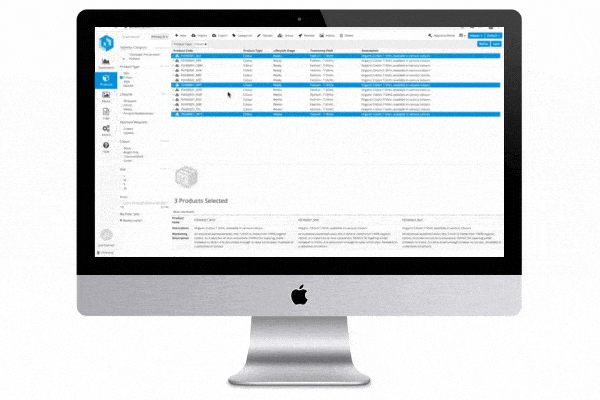Hit crucial fashion and apparel eCommerce KPIs with PIM. It will help you improve many aspects of running your business, from how quickly you get products to sell to elevating your AOVs. By benchmarking your KPIs against the competition on an ongoing basis, you’ll see how PIM makes a huge difference to your reputation and profitability.
Let’s look deeper into how a PIM platform like Pimberly influences each KPI.
1. Speed to market
To survive in a hyper-competitive industry like fashion and apparel, a fast STM is essential. Because trends are heavily led by celebrity styles, being first to market will be key in upping your sales, especially in fast fashion. Being first to market enables you to gain vital extra selling days, and your customers will be more likely to perceive you as the go-to online store for the latest looks and trends.
A lot of meticulous planning goes into campaigns around key dates and seasonal sales (think Valentine’s Day, Mothering Sunday, Labor Day, Black Friday, etc.) and your customers will want to get their hands on new outfits pronto. With PIM, you can lock and load everything well ahead of time to ensure campaigns run as successfully as possible. Everything from getting your keywords nailed to launching products and prices at a moment’s notice will mean you can sell the maximum amount of products at the optimal prices.
With PIM, you can also make bulk updates to your eCommerce sites, ensuring new products can be uploaded in seconds. And with the ability to auto-link digital assets to products, you can quickly ensure your product pages are in tip-top shape, ready to wow customers.
Setting up new shopping channels is also seamless with PIM – a few clicks and you can get your products live on marketplaces like Amazon, eBay, Zalando, Etsy, John Lewis, Walmart, and Poshmark. . Since many of the tasks involved are automated, you save precious resources. Scoping functionalities mean you can determine what data and digital assets are published to your different sales channels. This means you’ll always meet the different requirements of your various sales channels, and your products will rank higher.
Plus, all product data can be localized for different geographies thanks to Pimberly’s compatibility with powerful translation tools. Make sure you’re giving customers all the details they need, such as sizing information, in a format they understand to guarantee great online experiences. Get your products looking sharp on foreign marketplaces – 70% of online buyers already purchase from foreign sites1 – without wasting time manually translating your descriptions and other content.
There’s more. Pimberly lets you create workflows that enable automation. You can determine rules to ensure a product meets all the requirements before it’s published. Notifications are sent to the relevant departments, be that the eCommerce team when SEO work needs to be completed, or your photographers to verify that all related digital assets are present and enriched. Essentially, this means you’ll never publish a product with missing information. Products can be added to your various online marketplaces in bulk, increasing your speed to market without the added costs of boosting your headcount.
2. Shopping cart abandonment rate
Cart abandonment rates generally sit between 65%2 – 80%3 – far from ideal! To ensure users don’t vanish after clicking ‘add to cart’, Pimberly can help you level up your user experience in significant ways.
Complete product data visibility and powerful workflows mean you’re much less likely to launch a product with missing or inaccurate information. If you don’t address such problems, the buyer may have a question they can’t answer, leaving them with no choice but to abandon their cart. This is especially true for conscious consumers – if they can’t verify your ethical credentials, they’re likely to move on to a competitor that seems more trustworthy.
Site navigation plays a huge role in lowering cart abandonment. It should be effortless for a customer to find and add products to their cart, continue shopping, view their cart, and complete their purchase. PIM streamlines the buyer journey by making it easy to create structured data and multiple product categories for better site navigation, helping to reduce cart abandonment.
You can also combat a high cart abandonment rate by using thumbnail images (which you can easily set up with PIM) throughout the buying journey, ensuring your product is front-of-mind during the checkout process.
And of course, having returns and delivery information clearly visible early on in the buyer journey is critical. According to a USA customer survey by Baynard Institute, 49% of shoppers abandon their carts because extra costs are too high (shipping, tax, fees, etc.).4 By displaying this information before checkout, you’ll create more informed shoppers who are less likely to leave your site during a purchase. You can easily manage this data in PIM to make it a priority.
3. Cost of customer acquisition
The more efficient and effective your marketing strategy is the lower your cost of customer acquisition (CAC).
A priority should be optimizing your product pages for SEO – it’s an affordable way to boost product page discovery and increase organic traffic to your website, driving the effectiveness of your marketing.
Longtail keywords allow you to use accurate search terms as keywords (such as ‘organic cotton white t-shirt’). Whereas LSI (Latent Semantic Indexing) keywords make it easier for search engine bots to crawl your content and give it a higher ranking. Use a variation of both to boost SEO.
PIM makes SEO a breeze with unlimited keyword storage as well as easy product page and data asset optimization. Learn more in our white paper: The Ultimate Guide to PIM for eCommerce SEO.5
Speaking of PIM’s massive storage capabilities, it makes locking and loading campaigns well ahead of time hassle-free, saving you precious resources while making your campaigns more effective for customer acquisition.
And since PIM lets you set up and manage multiple marketplaces from one place, it’s easier to execute effective omnichannel marketing strategies, saving time and money while helping you attract customers from a wider variety of platforms. Scoping capabilities via PIM assists here too – you can determine which product details and digital assets are distributed to your different channels to suit respective audiences and to meet the different requirements of the sales channels you’re selling to.
Finally, PIM makes it easy to A/B test different product content using workflows (you can set rules for what copy needs to be published, when it needs to be published, and for how long). The results gained from this research will help you optimize your advertising content for greater marketing efficiency, lowering CAC.
4. Conversion rate
Amazing customer experiences. That’s how you drive conversion rates and increase revenue – 71% of consumers feel frustrated when a shopping experience is impersonal. And 44% say they will likely become repeat buyers after a personalized shopping experience with a particular company.6
Your competitors know this. And they’re investing in personalization to make their CX top dollar. How can you compete?
Enter hyper-personalization. It enhances the CX by using real-time consumer and behavioral data to deliver contextualized products or services for each buyer. AI is the key to obtaining this data, and there are plenty of tools you can integrate with your PIM to gain these insights. It can reveal what kind of products your customers are interested in, the channels they’re shopping through, and what they like about a product they purchased.
PIM makes it easier to process the information you want to personalize. Whether the data is coming from an ERP system or supplier feed, it’s all in one location.
And with data-led audience segmentation, you can make relevant recommendations as part of a cross-selling and up-selling strategy. Creating personalized product bundles additionally helps each customer find looks and outfits they’ll love.s.
Effective digital asset management (DAM) is also key to boosting conversation rates – 75% of shoppers consider product photographs while purchasing online!7 Better quality images and videos (including those with zoom and 360 views) make your products more compelling, increasing sales. Videos are also a great way of showing your customers what products look like when they’re being worn, how they should be worn, and what other items they can match with the product they’re looking at to create a complete outfit.
Publishing attractive digital assets is a breeze with Pimberly – it automatically resizes and optimizes images and videos according to each sales channel. Auto-linking also means your products get the right images without you lifting a finger.
While combining effective DAM with AI-driven data means you can use browsing history and personal details to show your customers compelling product images and videos you know they’ll be interested in. Not only does this enhance the user experience but it’s helpful when you’re creating ‘shop the look’ recommendations.
We’re not done yet! Scoping with PIM lets you tailor product data (adapting your brand tone of voice and identity) for different channels, increasing conversion rates through content optimization. And having structured data, filters, and other search functionalities will go a long way in streamlining the customer journey – all of which can be managed in PIM.
5. Customer lifetime value
High customer lifetime value (CLV) suggests strong brand loyalty, a great product-market fit, and repeat purchases from existing customers – all of which translates to a healthy business!
Encourage brand loyalty by engaging with your customers on multiple channels each time new collections are launched. With full visibility across all your shopping channels using PIM, this should be a simple process. It also helps you launch new products on time – your marketing team can promote them regularly to each segment, driving additional sales from your existing customer base.
Soft-touch marketing also fuels brand advocacy because you’re focusing on providing value through useful and educational content. Ellis Brigham is a great example of an apparel brand nailing their soft-touch content8, focusing on themes such as eco-friendly travel and photography – perfectly aligned with their audience of adventurers.
PIM makes managing and launching soft-touch omnichannel marketing campaigns seamless, automating many of the tasks involved with setting up new channels, adjusting your content for different audiences, and boosting SEO.
Bulk updates also allow rapid product launching. Ensure you stay on top of trends and create products that are a great market-fit, seducing customers with your ability to always be on point.
Are you a sustainable fashion and apparel brand? PIM helps you highlight what makes you ethical, from how you source your products to the way you treat workers, driving brand advocacy. Easily add certifications, brand story videos, and many more trust-boosting assets to your product pages with advanced DAM. Learn more in our white paper: Sustainability in Fashion & Apparel: Creating a Greener Future.9
6. Average order value
PIM shines when it comes to increasing average order value (AOV) – a fashion and apparel eCommerce KPI that illuminates your profitability.
Product bundling techniques such as ‘shop the look’ increase AOV by encouraging shoppers to buy more to complete their outfits. For instance, recommend matching accessories for a dress, or shirts and ties for suits. You can also encourage customers to spend more with “you might also like” prompts that showcase higher-value, similar products to create upselling opportunities. Market research by McKinsey suggests that 35% of all Amazon purchases come from recommendations (at least some of which qualify as ‘bundles’).10
PIM combined with AI tools give you the data needed to swiftly create personalized bundle recommendations, driving AOV further through tailored shopping experiences. For example, you can accurately cross-sell products based on a user’s search history. And with PIM’s unlimited storage, you can create endless product relationships, keeping your teams organized while enabling seamless cross and upselling.
Here’s an exciting fact: 66% of global consumers will pay more for ethically produced goods.11 Becoming a sustainable fashion and apparel brand isn’t just good for the planet – it can elevate your AOV too. And PIM is every eco brand’s best friend, letting you create new niches and reach new audiences with higher buyer intent.
7. Return rate
Returns are a fact of business like rainy days are a fact of life. In truth, if your return rate is around 30%, this is normal.12
But if this KPI is creeping above 30%, it might indicate issues with your product data. 27% of people worldwide cite ‘product not as described’ as their main reason for returning their online purchase.13
Ensure accurate product information with PIM. It gives you full visibility over all your product data, making it easy for your team to spot errors. While real-time updates enabled through workflows ensure any inaccuracies can be fixed immediately, reducing unnecessary returns.
Over 40% of clothing and shoes bought online are returned due to sizing issues.14 Often, a customer will buy several sizes of the same product to make sure they got the right fit. This will clearly lead to more product returns when they send back the ill-fitting products.
Pimberly enables you to overcome this issue with the Auto Sizing Chart feature. Create easy-to-understand sizing charts using templates and the product data stored within your PIM so customers always know which size will be right for them.
Give your customers more context around the product in the form of lifestyle shots with different use cases and different sized models. Provide details of the model i.e., age, clothing/shoe size, and height. You can also provide details around how many previous customers have returned products bought in this size, for example – only 17% of customers who bought this size returned it. =
PIM also lets you bulk upload sizing charts – the key to ensuring customers are more likely to purchase items they know will fit them. Also, consider sizing tools like ASOS’s. For example, it can tell you things like: “85% of people in your size range bought this item and didn’t return it” to build buyer confidence.
Immersive product experiences also provide more realistic product content, reducing returns. This includes adding user-generated content, videos with zoom and 360 views, plus professional-quality images to your product pages. Sophisticated DAM makes uploading and managing these assets effortless.
8. Stock turnover
High stock turnover typically means you’re selling your goods quickly, so there’s plenty of demand for your products – yay!
To increase product demand, get your goods in front of more people in your target market by opening new sales channels. And optimize your products for each market and its search engine – think keywords, metadata, alt text, all that jazz. Bonus: by making the most of new marketplaces, it’s easier to sell end-of-line stock. Selling on marketplaces and not on your eCommerce site means you can preserve your brand image. I.e., you can sell at much cheaper prices on marketplaces without this reflecting negatively on the products you’re displaying in your own store.
Expanding into new geographies broadens your reach too. PIM helps you set up new geographies as well as provide product information, such as sizing information and currencies, in different languages. This boosts accessibility and (by result) sales. Because you have massive storage capabilities, you can also localize and store other digital assets that will be suited to different cultures and preferences.
Also, set discount prices for specific time periods and depending on stock levels with workflows in PIM and integrations with your ERP or stock management system. Overall, this gives you the freedom to boost stock turnover exactly when you need to and at the optimal price.
9. Gross profit margin
This fashion and apparel eCommerce KPI is reliant on business efficiency. And PIM wins at efficiency!
PIM can automate up to 80% of the manual tasks involved in product management to reduce your costs and help you grow without hiring new people. This includes many tasks involved with stock management thanks to the ability to connect to your ERP system or supplier feed using PIM.
Because you can get products to market faster, you’ll be more likely to sell the maximum amount of products at list price. Additionally, by using techniques to increase basket size (like intelligent product recommendations, and shop the look), you can clear more stock, minimizing the need to apply discounts and EOL sales.
Moreover, bulk product updates reduce the time it takes to launch new collections. Sell your collections at full price for the maximum number of days possible per season, driving revenue alongside your team’s capacity. Plus, with an entire operation efficient enough to respond rapidly to market demands, you never miss out on additional profit.
High staff turnover can have a huge impact on profit – the Society for Human Resource Management (SHRM) predicted that every time a business replaces a salaried employee, it costs 6 to 9 months’ salary on average.15
A user-friendly PIM platform can remove friction for all your teams, streamlining collaboration, eliminating unnecessary tasks, and reducing mistakes. Team efficiency is maximized and your colleagues get the freedom to focus on their specific areas of expertise. The result? Job satisfaction levels rise as staff turnover lowers, increasing your gross profit margin.
10. Time to revenue
This KPI might be new to you. Time to revenue (TTR) focuses on the success of your products – it’s generally a more accurate measure of profitability than STM.
Boosting time to revenue relies on two things:
- Getting your products out quickly
- Improving the quality of your product data
PIM helps in both regards.
Bulk uploads make it effortless to expand your product range across all your different shopping channels. Start generating as much revenue as you can in just a few clicks. Note: rapidly uploading products doesn’t mean you’re more likely to have product pages with mistakes – PIM ensures all product data is complete before being published. How?
Flexible, configurable, graphical workflows improve visibility, making it much easier to spot mistakes. You can also set requirements for your team to complete before hitting ‘upload’. If a task hasn’t been completed, PIM will alert your team, giving them a chance to correct the problem before your products go live.
Ensure high-quality product pages with PIM. It can run your written content through a readability app, identifying grammatical errors and opportunities to improve the reader experience. PIM also helps your copywriters create better content using images and video. They’re able to see your digital assets in all their glory. This will inspire their content, resulting in compelling online experiences that are more likely to convert.











